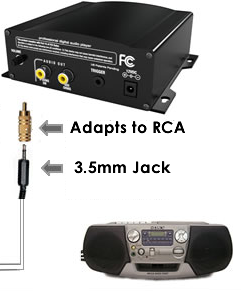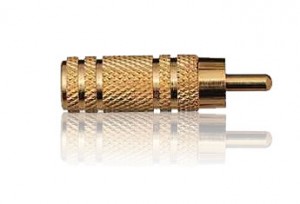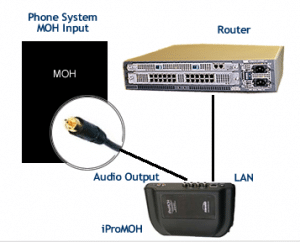Is music on hold installation a do-it-yourself project? It might be as easy as plugging in an audio cable. Here’s what you need to know.
THIS REPORT APPLIES TO: Connecting a professional music on hold player to an MOH input on a PBX or KEY style phone system. IT DOES NOT APPLY TO: Off-site or hosted PBX systems, non-PBX or KSU-less phone systems (i.e., ordinary office phones purchased at electronics or office supply store).
AUDIO TRAVELS FROM MUSIC ON HOLD PLAYER INTO PHONE SYSTEM
First, let’s take a look at the “big picture”. Audio is played continuously from the music on hold player. The sound travels from the AUDIO OUTPUT over the audio CABLE to the MOH INPUT on your phone system.

8 OHMS OR 600 OHMS? WHY TWO OUTPUTS? On the back of your music on hold player are two connections labeled AUDIO OUT. The 600-Ohm output is intended for telephone systems. (If your particular situation needs a louder signal, you may use the 8-Ohm output without harming your equipment.)
The 8-ohm output is appropriate for sound amplification systems, such as public address systems used by museums and amusement parks.
RCA CONNECTOR
Introduced by the Radio Corporation of America (RCA) this plug is also known as cinch/av or phono (a term  meaning phonograph, but too easily confused with phone, as in telephone). All professional music on hold players sold by Easy On Hold use an RCA connection for the audio output.
meaning phonograph, but too easily confused with phone, as in telephone). All professional music on hold players sold by Easy On Hold use an RCA connection for the audio output.

REPLACING RADIO OR CD PLAYER

If you are replacing an in-use audio source such as a radio or CD player with
your new professional music on hold player, remove the connection from the player and adapt the plug to RCA.
Adapters are inexpensive and easily found at electronic stores, or by calling Easy On Hold at 1-888-798-HOLD (4653). Shown: RadioShack 274-871.
NO PLUG AT ALL?
Perhaps your telephone technician connected wires for music on hold directly into your telephone system. Try connecting an RCA plug on the end for the music source.
A “punch-down block” is a device for attaching wires to phone systems. Your telephone technician may need to attach the on hold playback device there. A telephone technician using the proper tools will be required if changes to the punch-down block or any other part of your phone system are needed. Do not tamper with your phone system’s punch-down block.
TIPS & TRICKS
- Never force a 3.5mm (mini-plug) into an RCA receptacle. Once the inside of the receptacle is bent, the correct plug will no longer make the connection.Never plug an audio cable into a power receptacle. To be sure, plug in the AC power adapter first and see that there is power to the unit.
- Some on hold audio players come with a speaker button. Is the unit putting out sound? If so, turn the volume to 50% and call in. Once on-hold you can adjust the volume.
- If the audio seems to get faint or fade in and out, try more volume. Some phone systems have an anti-noise filter that will try to turn off the hold music unless a certain volume threshold is reached.
- If the audio is intermittent, check the connections at the player and the MOH input to be certain they are secure.
- All wiring must be insulated. Old audio cables may need to be replaced. Message on hold players purchased from Easy On Hold include one RCA-to-RCA cable and one RCA-to-3.5mm adapter plug for use with 3.5mm telephone system MOH input receptacles.
- Cell phone signals often distort or warp music on hold. Call in using a land-line for the clearest test signal.
- Callers hear the music on hold message in progress, not from the start. The player repeats the audio production over and over.
- There is no need to turn the music on hold player off. It is designed to play 24/7.
- A support ticket can be submitted online at www.easyonhold.com/support.
Get the full report: https://easyonhold.com/learn/on-hold-installation/Set-Up-Music-And-Messages-On-Hold/




